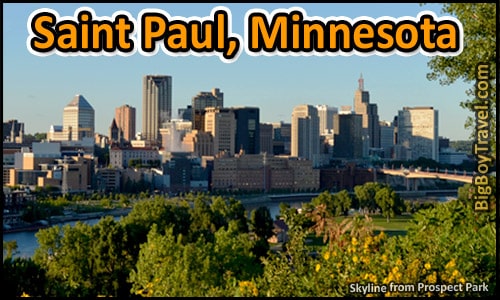Saint Paul, Minnesota:
It might not have the big lights of New York City, but the small-town feel, beauty, and friendliness of Saint Paul will make you feel at home. Whether you are strolling between Downtown sky scrappers, riding a historic Mississippi River Boat, or touring a mansion-lined boulevard, you’ll fall for this tree-filled city. Saint Paul is an alluring city that has seen F. Scott Fitzgerald write The Great Gatsby and Charles Schultz come up with The Peanuts & Charlie Brown.
The City of Saint Paul is also resilient and has seen 3M and Medtronic grow into global names. No matter what time of year, Saint Paul seems to have amazing festivals going on from the famed Winter Carnival to cultural events like Italian fest. During your visit to St Paul, you’ll quickly understand why it is often called one of the most romantic cities in North America.
Explore Saint Paul By Neighborhood:
5. State Capitol Area
6. Como Zoo & Park
7. Lower Town
Historical Overview of Saint Paul:
For centuries before pioneers arrived in the early 1800s, Saint Paul’s natural beauty and resources made it the perfect home for local Native groups. The area’s resources of wildlife, water, and lumber are also what drew the first settlers who originally called the area Saint Peter. After a series of lopsided treaties with the Native groups, the land was opened for development and the city quickly grew. Pierre (Pig’s Eye) Parrant was considered the 1st resident in 1938 when he built a small cabin near Fountain Falls. Because St Paul was the furthest up the Mississippi River that boats could go at the time, it soon became home to lumber, shipping, railroad barons looking to get rich. As these barons set up shop the City and Minnesota Territory were both officially established in 1849. St Paul naturally became the capitol, (which is still is today) as Minneapolis hadn’t even formed yet.
In the early years of Saint Paul industry boomed, dozens of millionaires were made, mansions sprung up everywhere, and a cultural melting pot formed from hoards of diverse immigrant workers from Europe. These factors together gave early St Paul a combination of charm and toughness which has carried the City through the years. From national rail lines to medical companies and more, industry leaders keep churning up in St Paul through the late 1800s. By the early 1900s, St Paul had become a sea of mansions as the money flowed like the Mississippi River. The biggest building accomplishment was the opening of the massive, and iconic, Cathedral of St Paul in 1915. The Cathedral is so impressive that the Vatican later declared it the National Shrine of the Apostle Paul.
During Prohibition in the 1920s, St Paul turned into the bootlegger capitol of the North as the city and police openly welcomed it in. Ironically the Prohibition law got its start in St Paul, but speakeasies popped up everywhere, even one in the Wabasha Caves. The police even let famous Gangsters live in St Paul as long as they didn’t commit crimes in the city limits. It is this very time period that inspired local writer F. Scott Fitzgerald to write the famed American novel The Great Gatsby. The 1930s and the depression weren’t so hot for St Paul as Industry and the money dried up for a while. Some wealthy residents were fine, but many others went flat broke cause tons of the finest mansions to fall into disrepair.
Luckily as St Paul rebounded in the late 1900s a number of the stately homes in St Paul over a dozen mansion districts were rehabbed, including 100s of the largest ones on Summit Avenue. Yes, we did says 100s of mansions were saved just on one street, which gives you an idea of how many there were. Along with the homes, many businesses also came through fine such as 3M (the maker of post-its and scotch tape) as well as Medtronic (made the 1st pacemaker). Over the decades the city has continued its comeback and has become the home to the Twin Cities best seasonal and cultural festivals.






